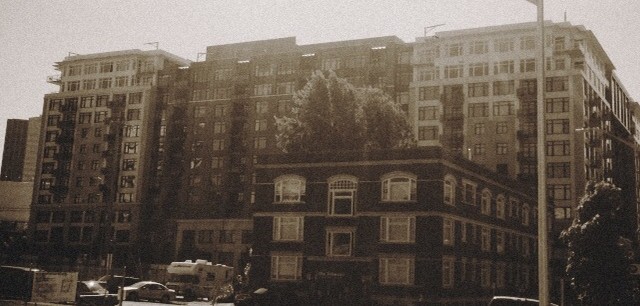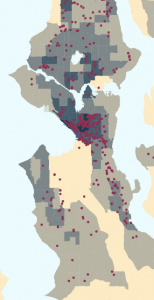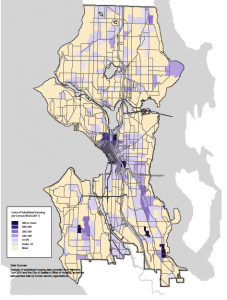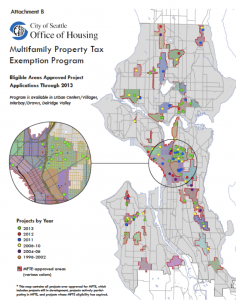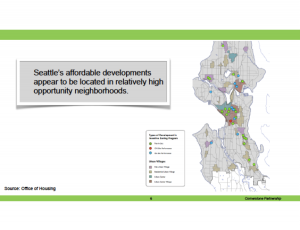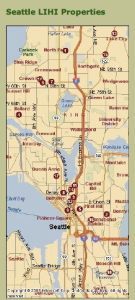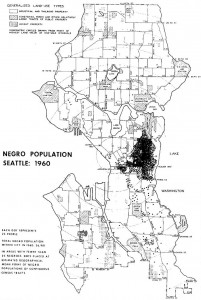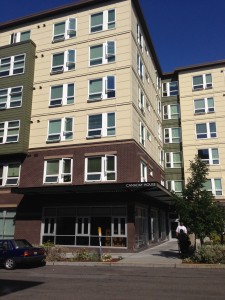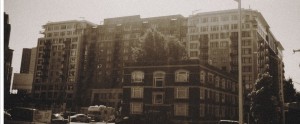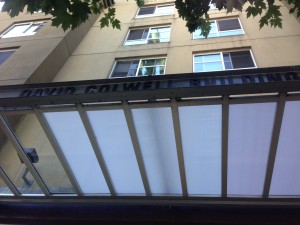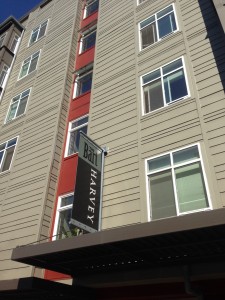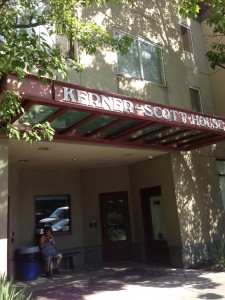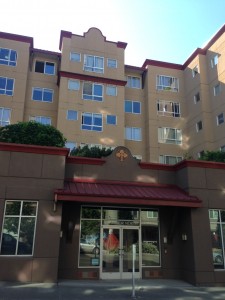Where Has All the (Affordable) Housing Gone? Everywhere.
Last week I responded to Chris Persons at the Capitol Hill Housing Improvement Program (CHHIP) who claimed that without inclusionary zoning, Seattle would end up a segregated city. I’ve offered Persons a chance to post a response here, without any editing, to keep the dialogue going (he hasn’t responded). And I have said to him and others, that everyone building housing in the city, for-profit and non-profit, have more in common than we might think.
Anyone building housing in Seattle faces the same regulatory challenges with permitting and other costs associated with building. In the follow up discussions from my post, I’ve been finding out that taking a pass on mandatory inclusionary zoning won’t lead to segregation by race and income, but, arguably, segregation of affordable housing doesn’t exist today. On the contrary, subsidized affordable housing exists in all quarters of the city.
Here are two maps created by the Office of Housing that illustrate the wide distribution of housing and where it is most concentrated.
(Click there to see the full map: Seattle Subsidized Housing by Housing Density)
(Click here to see the full map: Seattle_Block Group Map_Subsidized Housing Density)
Clearly , the city has a lot of buildings and units of subsidized affordable housing. There are areas (especially larger SHA operated housing areas like Holly Park and Rainier Vista) where there is still a much greater concentration than in other areas. But those areas are matched by many, many areas where there are lots of units and projects.
What about the Multifamily Tax Exemption (MFTE), a program aimed at people who earn 60 to 80 percent of Area Median Income (AMI) that has created thousands of units compared to the hundreds created by the underutilized Incentive Zoning program?
(Click here to read the full report: MFTE Annual Report)
Because the MFTE program is actually limited to urban villages and other areas of growth, when the program grows it creates more affordable housing in those places where Persons and supporters of inclusionary zoning say housing at 60 to 80 percent needed the most. The facts show that the MFTE program is creating housing priced at for 60 to 80 percent AMI all over the city at a rate much faster than Incentive Zoning, which produced, over a decade, only about 600 units. In 2013 alone, the program created over 3,000 units for people earning 60 to 80 of AMI.
What did the consultants hired by the City Council tell them about the distribution of housing in the city?
(Click here to see the full Power Point Presentation)
Cornerstone says that “Seattle’s affordable developments appear to be located in relatively high opportunity neighborhoods.” That includes neighborhoods like South Lake Union which has hundreds of MFTE units (see photos below) as well as larger buildings that are aimed at families, like the Denny Park Apartments. Here’s a description of that property from the Low Income Housing Institute’s (LIHI) website:
Denny Park Apartments (South Lake Union, Seattle)
50 units for families and individuals
26 studios, 11 one-bedrooms, 8 two-bedrooms,
5 three-bedrooms, 10 units are transitional
Here’s a map of LIHI’s properties which are all over the city, including in Queen Anne and Ballard:
Yet the hyperbole from the Housing Development Consortium continues unabated. Here’s a quote from a post by Emily Alvarado from in early in 2013:
For years, zoning has been a tool of exclusion designed to systematically segregate neighborhoods. But, Incentive Zoning can be a tool for equitable growth, helping build economically and racially integrated communities that enable modest wage workers benefit from urban reinvestment and connect to better schools and opportunity networks.
Then she posts this old map:
The implication is obvious. Do what we say and impose inclusionary zoning or you will be participating in a racist and segregationist policy. Of course Persons and Alvarado will gasp and clutch their pearls at such a suggestion, but the maps show clearly that they are wrong on the facts of what’s happening in the city and about incentive zoning’s value as a policy to reverse segregation, even if it existed. The only affordable housing program creating lots of units with limits on its location is the highly successful MFTE program.
What’s truly unjust is the gross misallocation of resources, rhetoric, and time that this city, the Council, and housing advocates of all kinds have wasted on a policy that so clearly does little to solve any problems, especially the one we don’t have, which is the supposed undersupply of workforce housing. The scarcity is at lower levels of income, and while waiting lists for that housing grow as does the suffering of poor people, Persons, the Housing Development Consortium, and some Councilmembers plow ahead, using the politics of race and class welfare to tax new housing to funnel subsidies to people that earn $50,000 to $60,000 claiming that it will integrate and better distribute subsidized housing. Where has all the affordable housing gone? It’s everywhere.
While I was writing this on Capitol Hill I ran down and across the freeway to get a quick picture of the Denny Park Apartments. But I realized I was disoriented. The Denny Park Apartments are further away than I thought. So I snapped pictures of these 6 affordable buildings in about 5 minutes. I haven’t calculated how many units of housing I was able to identify on foot, without a map, and just looking at the outsides of the buildings. I came back and confirmed the names, ownership, and addresses of the buildings. The next time someone says the South Lake Union has no poor people, or that people are being displaced to make way for luxury apartments consider these actual people living there today. Then tell me we’re segregating our city.
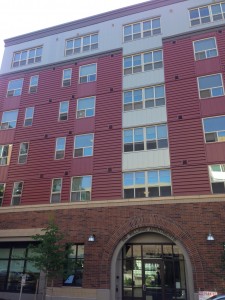
Pat Williams Apartments
Plymouth Housing Group
Pat Williams Apartments
219 Pontius Ave N., Seattle, WA 98109
